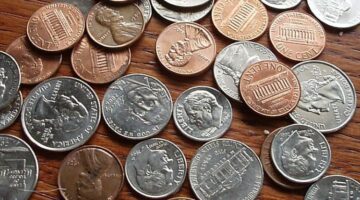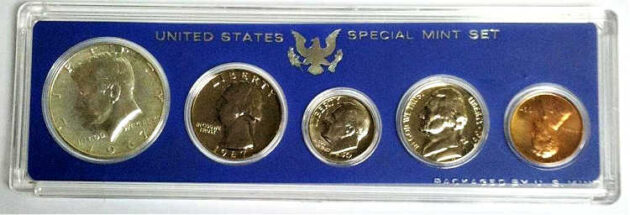Over the course of collecting coins, you’re going to find that there are many different kinds of strikes the United States Mint uses to produce its coinage.
Striking a coin refers to pressing an image into the blank metal disc, or planchet, and is a term descended from the days when the dies were struck with hammers to deform the metal into the image of the dies.
~ Source
What are these different kinds of coin strikes called? And how are they distinctive from each other?
Today we’re going to explore the 3 types of coin strikes and how you can tell them apart…
#1 – Business Strike Coins / Circulation Coin Strikes

Yes, these are the same thing — but they’re often referred to by one of the two terms.
A business strike is a coin made for circulation. Or, changing the perspective slightly, a circulation strike is a coin made for commerce and conducting business.
Business strikes make up (by far!) the largest proportion of coins produced at the United States Mint.
Why does the U.S. Mint make business strikes for circulation anyway?
The United States Mint was founded in 1792, and it is tasked with the primary role of making coins for commerce. Any sovereign nation needs money to establish an independent economy, and this is what the U.S. Mint does — it makes money to help the United States economy function.
The mint, at the end of the day, is simply a coin-making factory. The largest output percentage of these coins are designed to slide right into circulation and help our economy work.
Even in a day and age when more and more transactions are dependent on the use of plastic cards or payment apps, the foundation of the American economy is based on dollars and cents. And that’s exactly what the U.S. Mint does — make physical dollars and cents.
How can you tell a business-strike coin from other types of coin strikes?
Virtually all of the coins you have ever seen in your loose change are business strikes. They constitute the most basic manifestation of a coin — usually being struck just once on a fairly dull-looking piece of metal.
Want to see how the U.S. Mint makes these coins? Check out this video:
The process of making a coin involves several steps with heavy machinery — and all of these coins get bagged up together and shipped around the United States for distribution. During this journey, those business-strike coins will accumulate dings and scratches.
Now, most business-strike coins may look shiny (or even a bit reflective) when they’re new. This is a result of natural mint luster, as seen on coins that are unworn and produced on fresh metal — not because of any special process undertaken at the mint.
Very few coins made for circulation are ever seen without at least a few significant contact marks on the surface.
This is one reason that some of the rarest coins around (from the “condition” standpoint) are circulation strikes that grade above MS66 or MS67. And the bigger and heavier coins are, the more likely they are to show contact marks — due to the jostling they encounter in bags while en route to the bank.
#2 – Proof Strike Coins

Since the middle decades of the 19th century, the U.S. Mint has produced high-quality coins solely for collectors. These coins are known as proofs.
Proof coins are made with some of the finest minting technology!
They exhibit remarkable strike detail and impeccable surfaces. They are generally made with polished coin blanks and specially prepared dies, and they’re struck twice on high-tonnage presses to bring up even the most minute details.
It’s important to note in this conversation that “proof” refers to a method of manufacture and not a condition or grade. Even in the case of proofs that entered circulation, they are still referred to as proof coins — but they are given wear-based numerical grades commensurate with the amount of wear they have seen.
Most proofs produced at the U.S. Mint feature squared-off rims, absolutely exceptional detail, and mirrorlike surfaces.
Here’s a glimpse at how proof coins have changed through the years:
- In the early decades of the 20th century it became somewhat custom for the U.S. Mint to produce proofs that feature matte-like surfaces but still carry the refined detail in the design, lettering, and rim.
- By the late-1970s, most proofs made by the U.S. Mint were exhibiting cameo or frosted highlights on the designs and lettering, resulting in whitish devices against a darker or black flat surfaces — which are known as fields.
- In more recent years, the U.S. Mint has launched reverse proofs. These essentially flip the cameo frosting to the fields and impart mirrorlike sheen on the devices — a reversal of the the cameo proofs that have become otherwise standard since around 1980.
Proof coins are usually issued in proof sets. Some are released as individual product options — such as proof American Silver Eagles and proof commemorative coins.
#3 – SMS Coin Strikes / Specimen Strikes
The specimen strike is a little more ambiguous in some respects and is often confused with nice-quality circulation strikes and matte proofs — all of which can look similar to one another under the right light.
Specimen strikes are also the least known by many hobbyists. As a result, they’re often little understood.
A specimen strike is a coin that was carefully:
- Handled by U.S. Mint employees from the stage of blanking or planchet preparation.
AND
- Struck by dies that were themselves specially handled before and during striking.
The reasons that specimen coins are usually struck so meticulously is because they are either intended for special presentation (such as to a dignitary or another prominent individual or group) and/or they are being sold to coin collectors.
One of the earliest known specimen strikes among U.S. coins is a 1794 Flowing Hair dollar that some theorize was the very first silver dollar specimen ever struck at the U.S. Mint. This coin is graded Specimen-66 by Professional Coin Grading Service and sold for $10,016,875 in 2013. It was the most expensive coin ever sold at public auction until 2021.
While some specimen strikes are indeed rare and valuable coins, most of the ones that collectors are personally familiar with can be had for a whole lot less than $10 million!
Here’s a good summary of specimen strikes:
- In the mid-1960s, the U.S. Mint temporarily stopped making proof sets and mint sets — to help focus production capacity on making business-strike coins for circulation to allay a dire coin shortage. So, from 1965 through 1967, the U.S. Mint made Special Mint Sets. Not quite proofs — but much better in overall quality than circulation strikes — the coins in these Special Mint Sets are widely known as SMS coins and are usually regarded as specimens.
- From 2005 through 2010, U.S. Mint sets were composed of coins bearing a satin finish. These coins (which generally boast better surface quality than their standard circulation-strike counterparts) are also considered and graded as specimens.
- Many other U.S. Mint coins made for collectors that aren’t categorically business strikes or proofs are also recognized as specimens.
Do You Know The Grade Of Your Coins?
To determine the true value of your coins, you first need to know what condition (or grade) each coin is in.
Grab a coin magnifier and a copy of the U.S. Coin Grading Standards book. Then, watch this video to see how to grade coins yourself at home:





